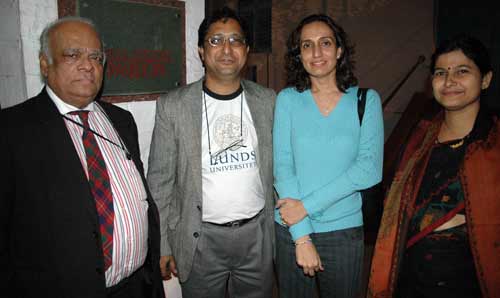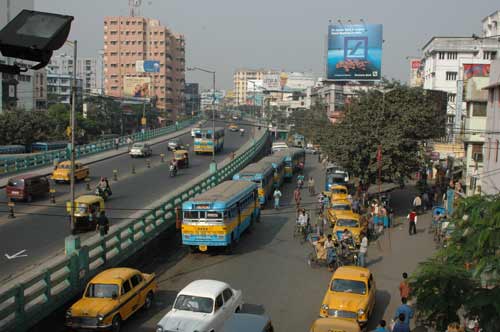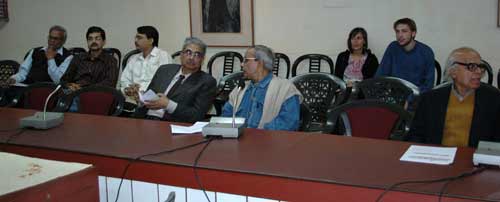SWEDISH SOUTH ASIAN STUDIES NETWORK
Visit to the Centre for Built Environment (CBE), Tuesday 13 December 2005
 |
| Prof. Santosh Ghosh, Mr. Unmesh Kirtikar, Ms. Unmish Kirtikar, Ms. Monica Khosla Bhargana and Dr. Mahua Mukherjee. |
The Centre located at Sarat Bose Road in south Kolkata is something as rare as an academic NGO and an ‘organisation of architects, city planners, environmental engineers and scientists who work for better and appropriate habitat and architecture, human settlement and environment within the context of sustainable development.’
We had been invited by the President, Professor Santosh Ghosh, and Mr. Unmesh Kirtikar, architect and associate of the CBE. Unmish Kirtikar and two other associates of CBE, Dr. Mahua Mukherjee, now Prof. of Architecture at the Indian Institute of Technology (IIT) in Roorkee and Ms. Monica Khosla Bhargana, also archiect, have all attended courses at Lund University in the Division of Housing Development and Management; Department of Architecture and Built Environment, led by Prof. Johnny Åstrand. They informally call themselves the ‘Lund Alumni Association in Kolkata’.
CBE was established in 1992 and draws people from all walks of the academic and practical spheres engaged in built environment issues and interested to come together in joint discussions and research work. It has three main fields of interest:
• Conservation of human habitat of value
• Energy production and consumption
• Water issues related to habitat
To this end the centre organises seminars and conferences. It takes
upon itself to assimilate and then disseminate new knowledge. It also
undertakes minor research projects and consultancies. It brings out a
number of publications and an annual Newsletter. An important activity
is to help bright young students to go for training in specialised academic
institutions abroad (when the Government selects, seniority and rank take
precedence!). Interestingly enough they also advice students on how to
conduct their research work in a fruitful way! (What are the academic
institutions doing?) CBE sees itself as a facilitator in the field of
habitat and environment research work.
CBE is acknowledged and authorised by UN agencies like UNDP and UNESCO
as well as the World Bank to undertake studies and organise conferences.
”We have chosen a simple form of voluntarily coming together to overcome the bureaucracy and infighting in academic institutions in order to create a functioning organisation about those issues that we would like to develop,” says Prof. Santosh Ghosh. He is a retired chief architect of the Calcutta Metropolitan Planning Organisation with a vast experience of working in Kolkata institutions, but also in the USA, Iraq and Jordan.
This is one interesting variety of the otherwise often money spinning
NGOs in India, who present fabulous prospects, get funding from various
foreign agencies and then disappear at the time of accountancy.
CBE has been actively engaged in the United Nations Human Settlements
Programme (UN-HABITAT) Conference in Istanbul in 1996 and will again organise
a session in the next conference in Vancouver in 2006, more
information on the he World Urban Forum 2006.
It will also organise a session at the 4th
World Water Forum in Mexico City in 2006, and most interesting for
us organise a panel called ”South Asia, cities and villages”
at the 19th European Conference
on Modern South Asian Studies to be held in Leiden, Netherlands in
June 2006.
What CBR does is really to engage a number of researchers in their vast
network of academic institutions, like the Indian Institutes of Technologies
all over India, to write high quality papers for these conferences.
Recent examples of issues that CBE has been engaged in:
• Toilet solutions fitted to poor households and a monsoon tropical climate
• The Gujarat earthquake in 2001 and plans for regeneration of cities in the affected areas
• The Tsunami – how to rebuild habitat and communities? How to prepare for the next flood wave?
 The
aim is to find out sustainable solutions honouring valuable traditions
and to advise governments and NGOs about it.
The
aim is to find out sustainable solutions honouring valuable traditions
and to advise governments and NGOs about it.
Of late, CBE has taken a lot if interest in Water issues, which it thinks
is now one of the crucial issues for a sustainable habitat in India. They
have looked into the phenomenal growth of new cities like Bangalore, where
there is hardly any planning of adequate water supply and sanitation systems
at all compared to the old imperial cities like Bombay and Calcutta. They
have looked into the whole issue of supply drinking water in rural areas
and what it means to the social fabric, especially gender relations. With
stable water supply many more girls can attend schools since they need
not walk miles all day just to bring it home to the house. They have looked
into the reuse of cleaned sewage water in big cities in terms of fish
and vegetable production. And they have surveyed the culture of water
in India, its ritual and symbolic significances.
With recent experience from Kolkata, they now also see one possible
progressive development to ease the pressure of a mega-city. The West
Bengal Government’s effort to achieve rural development through
land reforms and other interventions has actually created a reversed trend
in terms of migration. Many people now return to the rural areas to take
up productive activities in industry and services in an environment free
from many of the worst vices of the overcrowded city. Could that happen
in other parts of India as well? Why should India and other developing
countries urbanise at a crash rate never really experienced in the now
“developed” world. Could there be a creative alternative?
It is almost too good to be true!
Seminar on the Changing Face of South Asia
 After
a very tasty Bengali lunch at a restaurant in the Ballygunge area, we
all went to the seminar on ‘The Changing Face of South Asia:
Society, Culture and environment’ organised by the Centre in
the Academy of Fine Arts, next to St Paul’s Cathedral and Kolkatas
famous concert hall Rabindra Sadan, in the southern part of the city centre.
After
a very tasty Bengali lunch at a restaurant in the Ballygunge area, we
all went to the seminar on ‘The Changing Face of South Asia:
Society, Culture and environment’ organised by the Centre in
the Academy of Fine Arts, next to St Paul’s Cathedral and Kolkatas
famous concert hall Rabindra Sadan, in the southern part of the city centre.
There was variety of speakers, from here and abroad and there were about 30 persons in the audience, and among them also PhD candidate Ferdinando Sardella from the Department of Religious Studies, Göteborg University, who was in Kolkata to do fieldwork on Vaishnavism in Bengal during the vital beginnings of the 20th century.
Staffan gave the keynote speech about the Trichy 25 year panel study, which was appreciated. At the end of the seminar we also got a chance to present SASNET.
We don’t know how CBE had picked up two PhD students from Portugal
and New Zealand. One of them, Sandra Cristine Simoes
Marques from the Dept. Of Anthropology, University of Lisbon, spoke
about ‘Changing perceptions of their tourism – Maldives,
Bhutan and Kolkata-West Bengal.’ Did you know that of all the
close to 3 million tourists every year to India, only about 3 % or about
one lakh end up in Kolkata? Most tourists go to Goa and the so called
north-western triangle of Delhi-Agra-Jaipur.
Kolkata today is the favourite spot of only a limited number of backpackers
and people on their way to Darjeeling and the eastern Himalayas. West
Bengal has no desire to attract mass tourism, but chooses to develop a
few cultural and natural sites for limited tourism. That is also the route
taken by Bhutan with its 220 dollar a day group package tours into the
country, which do limit the number of tourist to about 10 000 a year.
The Maldives have chosen the opposite strategy: on 80 of its thousands
of islands, complete enclave resorts have been built which now attract
about half a million tourists annually. But the result is a thorough change
of culture of the male society, with marginalised women and children left
behind at starvation levels on the “virgin islands” not open
to tourism. The tourist economy has now overshadowed all other economic
activities.
 Prof.
Santosh Ghosh then gave a very interesting overview of the ‘Changing
Landscape of South Asian Cities’, the most frightening point
being the anarchic growth based on private property and real estate markets.
There is ‘Manhattanisation’ at one end and the growth of slums
at the other. Urbanisation also means the growth of new informal jobs
not least in the service sector catering to the new moneyed class. Dr.
Mahua Mukherjee talked about house building in this new context. It is
not easy but a real challenge to provide good housing based on traditions,
space for all new service and Indian social relations, and a habitat which
reinforces inherited identities. At her university, there is now a project
on how to construct buildings that can withstand earthquakes.
Prof.
Santosh Ghosh then gave a very interesting overview of the ‘Changing
Landscape of South Asian Cities’, the most frightening point
being the anarchic growth based on private property and real estate markets.
There is ‘Manhattanisation’ at one end and the growth of slums
at the other. Urbanisation also means the growth of new informal jobs
not least in the service sector catering to the new moneyed class. Dr.
Mahua Mukherjee talked about house building in this new context. It is
not easy but a real challenge to provide good housing based on traditions,
space for all new service and Indian social relations, and a habitat which
reinforces inherited identities. At her university, there is now a project
on how to construct buildings that can withstand earthquakes.
Prof. Ghosh held a similar presentation at the International Conference
for Integrating Urban Knowledge & Practice, held in Göteborg
in June 2004. The paper was titled ”The Changing Lifestyles:
Changing Cities. Perspectives from Asian Megacities”.
Another presentation at the seminar was about the Organisation of Women’s Unity in Howrah, which works among Muslim women in the slum (called basti in Kolkata). PhD Candidate Lorena Gibson from Massey University in New Zealand was studying the impact of informal education and small scale food production on these women’s lives.
The seminar ended with a speech on ‘Impact of Globalisation and Changes in the Economy of South Asia by Dr. Mahalaya Chatterjee, Centre for Urban Economic Studies, Calcutta University. India has so far managed to achieve a higher growth rate while gradually opening up to the world economy, a process that now seem irreversible. Due to its limited exposure earlier, it was also not affected by the investment crisis in East- and Southeast Asia in 1997-1998. The government control of the economy is loosening, and there is now less reliance on the government for having things done. The global consumption culture has reached the middle and upper classes with Internet and new identities and lifestyles. In a Pizza Hut Restaurant one could be anywhere in the world. New housing is growing phenomenally with banks providing loans at low rates.
 Other
persons we met during the seminar were the architectural engineer and
CBE Secretary Mr. Ranajit Gupta,
and Mr. Sunandan Roy Chowdhury,
Editor and Publisher of the magazine Sampark,
Journal of Global Understanding. Mr. Chowdhury (photo to the right)
was very keen on establishing a relation with SASNET. In 2001 Sampark
published a special issue on Sweden, ”Children's World In A Scandinavian
Nation”.
Other
persons we met during the seminar were the architectural engineer and
CBE Secretary Mr. Ranajit Gupta,
and Mr. Sunandan Roy Chowdhury,
Editor and Publisher of the magazine Sampark,
Journal of Global Understanding. Mr. Chowdhury (photo to the right)
was very keen on establishing a relation with SASNET. In 2001 Sampark
published a special issue on Sweden, ”Children's World In A Scandinavian
Nation”.
SASNET - Swedish South Asian Studies Network/Lund
University
Address: Scheelevägen 15 D, SE-223 70 Lund, Sweden
Phone: +46 46 222 73 40
Webmaster: Lars Eklund
Last updated
2009-02-25
